Teriyaki Spam Musubi is a local favorite from Hawaii filled with teriyaki fried Spam, furikake, and short-grain rice wrapped in nori. It's the perfect low-effort snack or lunch treat for a beach day, game day, potluck, or picnic.
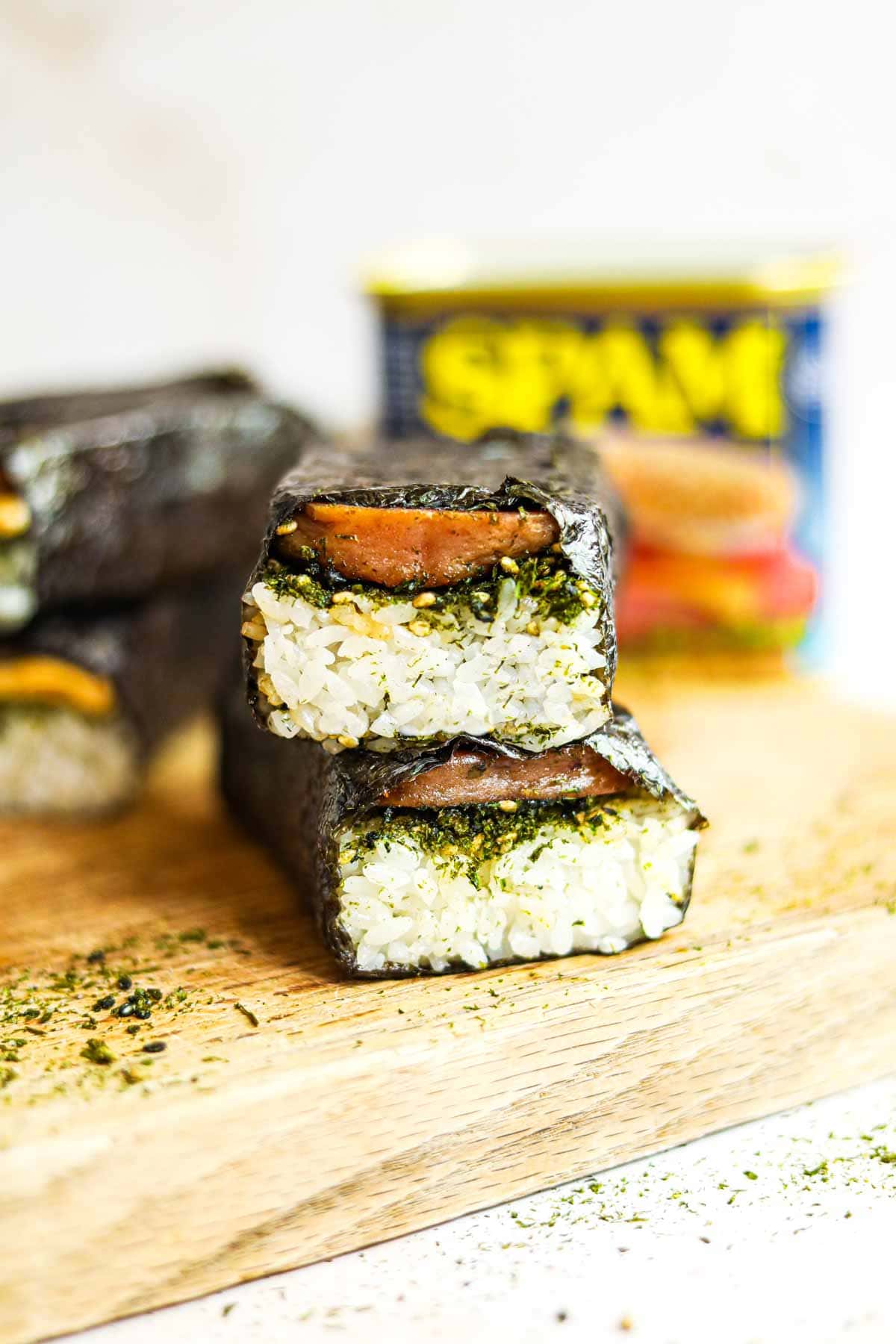
Spam musubi is a quintessential snack from Hawaii and a twist on the Japanese omusubi, or Japanese Rice Balls. It's commonly enjoyed as an on-the-go snack that can be easily transported, as they're individually wrapped. Musubi is so common and celebrated in Hawaii that you can find them pre-made at any local 7-Eleven or market.
This recipe is truly authentic and made using our Fried Spam method, which infuses umami-packed teriyaki flavor in each bite of Spam. We add furikake for ocean flavor to a bed of fluffy Japanese short grain rice. All you need is a musubi mold and your appetite!
Jump to:
About Spam Musubi
- Taste - The spam, rice, and nori combine to create a uniquely satisfying bite.
- Texture - The rice is soft, the Spam is firm, and the nori adds a little crunch.
- Effort - You just need to cook the rice, fry the Spam, then wrap the Spam and rice in nori.
- Time - Depending on how you prepare the rice, making spam musubi takes 50 minutes to make. Save time by frying the Spam while the rice cooks.
What is Spam?
Spam stands for Special Processed American Meat and is mainly pork and ham. It was created in 1937 in Austin, Minnesota and slowly gained popularity after that. Today, it is hugely popular in Hawaii and is a big part of local culture. People in Hawaii love it with rice, especially in spam musubis.
What is Spam Musubi?
Spam musubi typically features spam and rice wrapped in nori, but there are endless variations of meat that can be substituted for Spam. We also love to add teriyaki sauce to our Spam musubi for extra rich flavor.
Ingredients
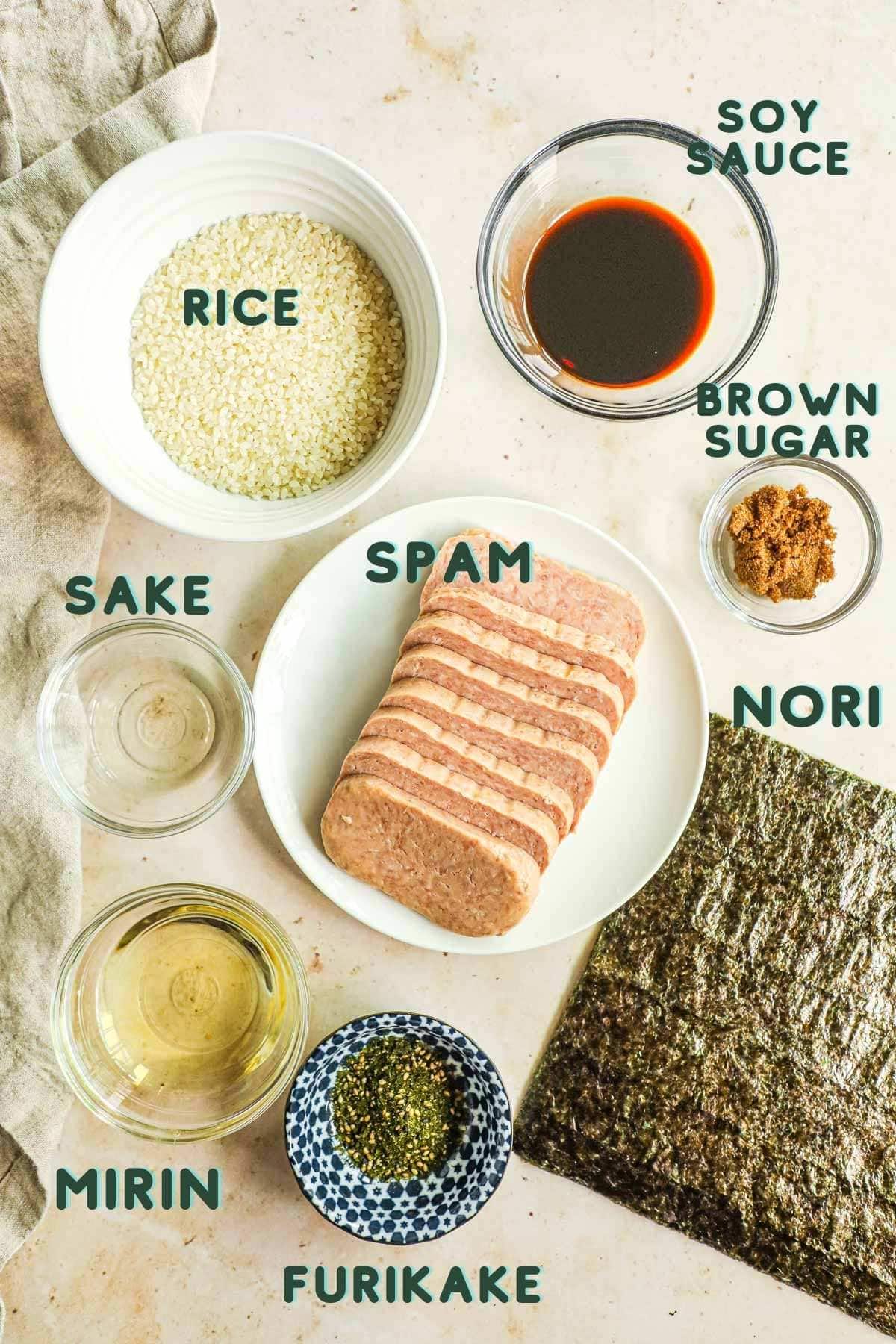
Musubi
- Spam - Spam is a surprisingly delicious and flavorful meat. We use low sodium because it is slightly healthier without sacrificing flavor.
- Rice - Japanese short grain rice is best for musubi because it is both sticky and fluffy enough to retain its shape. Unlike sushi rice, this rice should not be seasoned with rice vinegar.
- Nori - Nori is dried Japanese seaweed that is used to wrap the musubi and keep the rice and spam together. Nori sheets also provide a makeshift handle to eat the musubi and tastes delicious with the other ingredients.
- Furikake - Furikake is a Japanese seaweed seasoning consisting of dried nori, sesame seeds, and salt. Sprinkling furikake on the musubi adds a new flavorful dimension.
Teriyaki Sauce
- Soy sauce - Soy sauce, or shoyu in Japanese, is an essential condiment in Japanese cooking and adds a rich umami flavor to the teriyaki sauce. We use low sodium shoyu because it is healthier without sacrificing flavor.
- Mirin - Mirin is a Japanese sweet rice wine that adds umami flavor and is the base of many Japanese sauces.
- Sake - Sake adds savoriness to the teriyaki sauce.
- Brown sugar - Use brown sugar or light brown sugar to provide sweetness.
See recipe card for quantities.
Substitutions
- Store-bought teriyaki sauce - You can replace our homemade teriyaki sauce with store-bought teriyaki sauce if you want to save time.
- Brown Rice - Japanese brown rice is a healthier option, but make sure to use plenty of water so the rice is sticky enough to form stick together.
- Portuguese Sausage Spam - This special Spam combines 2 of Hawaii's favorite meats: Portuguese sausage and Spam. The combination is surprisingly delicious.
- Gluten free - Soy sauce contains gluten. In order to enjoy this recipe gluten free, replace traditional soy sauce with gluten free soy sauce or tamari.
Variations
- Mini musubis - Cut the musubis in half to enjoy them as snacks or if you want to make musubis for a party or potluck.
- Spicy - Add sriracha or your favorite hot sauce to make the musubi spicy.
- Garlic powder - Garlic powder will add the quintessential pungent aroma to the musubi.
- Egg - Add an egg for a savory and delicious addition.
Instructions
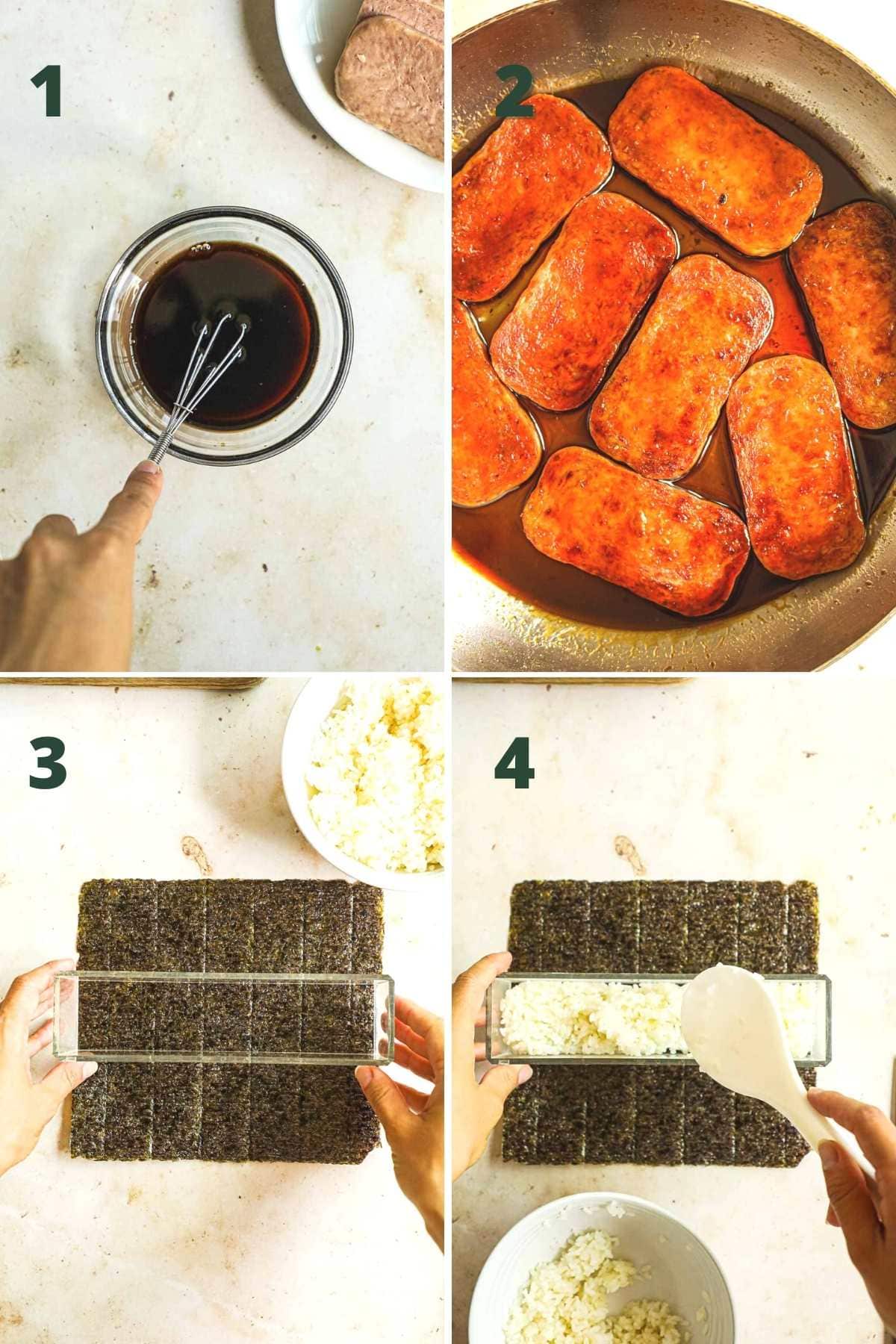
Rice
- Stovetop instructions - Place rice in a saucepan and rinse the rice in the sink until the water runs clear, then drain. Then combine washed rice and filtered water in a medium saucepan. Bring the rice to a low boil, then reduce to low heat. Cover the pot and simmer for 20 minutes or until the water is absorbed. Remove from the heat and let sit covered for 10 minutes. Fluff the rice with a fork.
- Rice cooker instructions - Place rice in the electric rice cooker pot and rinse the rice in the sink until the water runs clear, then drain. Then combine rice and filtered water in the pot and cook per the rice cooker directions.
Teriyaki Sauce
- While the rice cooks, make the teriyaki sauce. Add soy sauce, sake, mirin, and brown sugar to a mixing bowl and whisk. Set aside. (Photos 1)
Spam
- Cook Spam - Cut the Spam lengthwise into 8 equal slices. In a large skillet over medium heat, cook Spam slices 3-5 minutes or until caramelized, flipping halfway through. Then add teriyaki sauce and cook for 2 minutes or until the slices are coated. Remove from heat. (Photo 2)
Musubi
- Assemble musubi - Place the nori shiny side down on a dry cutting board. Then place the musubi maker in the center of the nori sheet. Wet a rice paddle or spoon with water and scoop rice into the mold so it’s evenly filled at about ¾ inch high. (Photos 3 and 4)
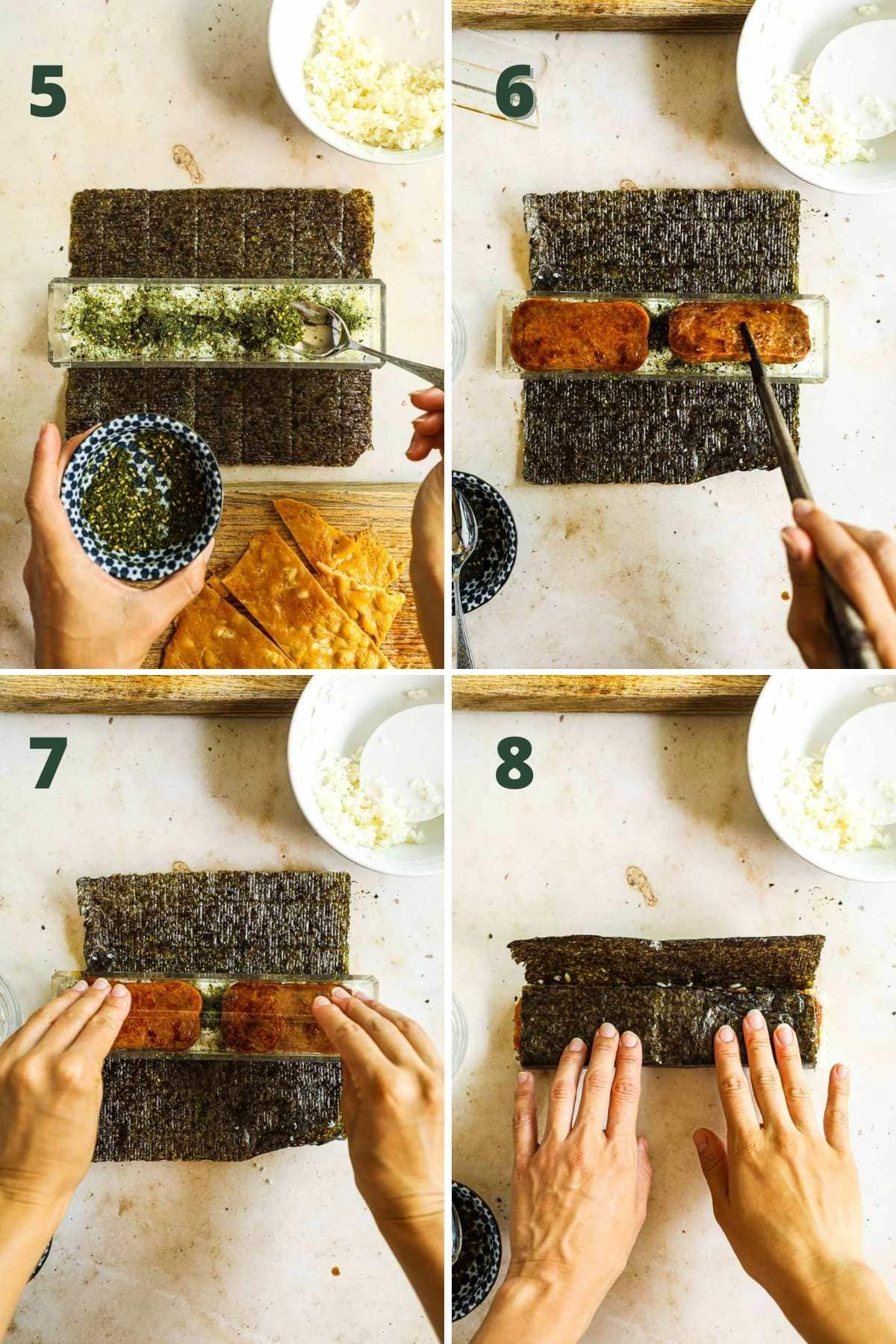
- Add furikake and Spam - Sprinkle furikake on top of the rice, then add a single layer of Spam. Make sure the Spam carries over some of the sauce from the pan. (Photo 5 and 6)
- Press the musubi - Use the top of the musubi press and gently push down on the Spam to compact the rice. Then remove the mold and tightly wrap the nori over the musubi. (Photo 7 and 8)
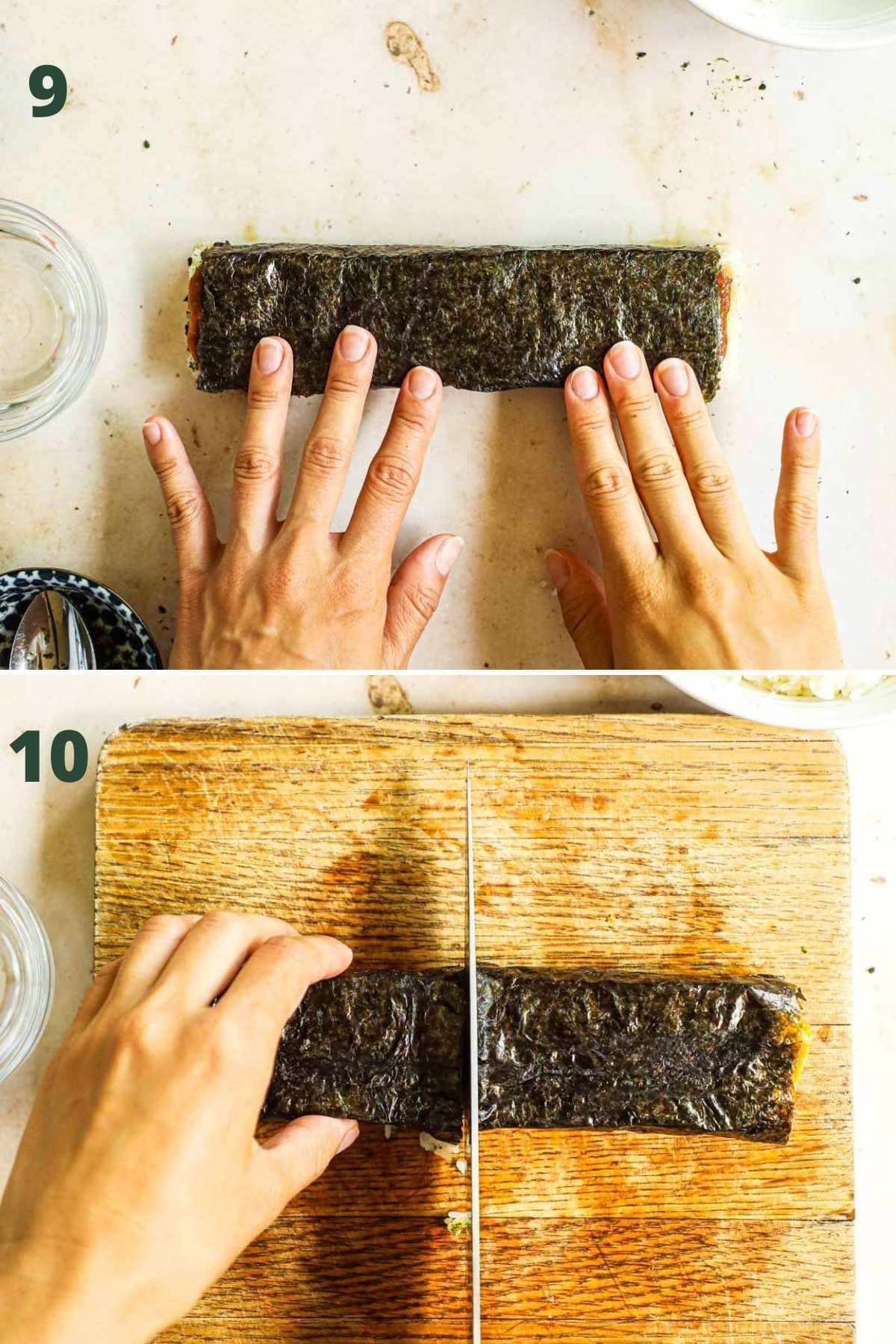
- Wrap and slice - Dab a little water on the inside of the top layer of nori to seal the musubi. If using a double musubi mold, wet a sharp knife and slice in half to create two musubis. The wet knife helps prevent the rice from sticking. (Photo 9 and 10)
Pro tip: Nori has a shiny side and a rough side. The shiny side is for the exterior of the musubi and the rice sticks to the rough side.
What to Serve with Spam Musubi
Spam musubi is a perfect snack or light lunch. We usually enjoy it with a Matcha Lemonade or Iced Hojicha Latte. If you want to make a more filling meal, enjoy it with our Spicy Kani Salad or Furikake and Lemon Shishito Peppers.
Other Types of Musubi
- Teriyaki chicken musubi - Grilled teriyaki chicken is a great musubi alternative.
- Chicken katsu - Chicken katsu is a crispy, golden brown chicken cutlet. It will also taste delicious with rice wrapped nori.
- Teriyaki hot dog - Teriyaki hot dogs are an umami packed upgrade to normal hot dogs.
- Breakfast musubi - Use Portuguese sausage, Portuguse sausage Spam, and egg to make a yummy breakfast musubi.
- Unagi - Unagi is broiled Japanese eel dressed in unagi sauce, a sweet and savory sauce. Unagi can be enjoyed in a musubi or hand roll.
- Tempura - Shrimp or vegetable tempura will add a delicious crunch to the musubi.
- Onigiri - Onigiri are triangular rice balls wrapped in nori. Like musubi, they can be enjoyed with a variety of fillings.
Recipe FAQs
Musubi or omusubi is a Japanese dish where rice is wrapped in nori. Spam musubi is a Hawaii variation of musubi.
Spam was introduced to Hawaii during World War II. During World War II, the U.S. government served SPAM to soldiers stationed in Hawaii since SPAM is cheap and non-perishable. There was so much Spam that it ended up sold in stores around Hawaii and eventually adopted into local culture.
Spam musubi can be enjoyed hot or cold, making them a great snack or lunch on the go. We prefer our Spam musubi room temperature or slightly warmed up. In order to warm up the musubi, you can heat them in the microwave briefly.
Spam musubi sauce is often made of the same ingredients as teriyaki sauce or something very similar. It often includes soy sauce, mirin, brown sugar, and sesame oil or sake.
You can make Spam musubi up to 3 days ahead of time. We often make a bunch to have for lunch over a few days.
Musubi can fall apart for a few reasons. First, make sure you are using Japanese short grain, sticky rice. Short grain rice has a lot of starch which helps it stick together whereas longer grain rice has less starch and won't stick together well. Also, make sure the rice is still warm and not cold when you try to mold it otherwise the rice won't stick together.
Equipment
This musubi recipe requires kitchen essentials. For the rice, you will need a pot or rice cooker, and a rice paddle. The teriyaki sauce requires measuring spoons and cups, a mixing bowl, and whisk. For the spam, you will need a knife, cutting board, non-stick pan or standard skillet, and silicone baking spatula or tongs. To form the musubi, use a musubi mold.
Storage
These musubi can be refrigerated in an air-tight container or plastic wrap for up to 3 days. The key is to keep the moisture locked in so the musubi doesn't dry out. If you want to take the musubi to go for lunch, plastic wrap or a bento box will both work well. These ingredients do not stand up well to freezing.
Top Tip
- Make sure you wet your rice paddle before you pick up the rice so the rice doesn't stick to the paddle.
Related Recipes
Did You Like This Recipe?
Love this Spam musubi recipe? Please leave a 5-star rating in the recipe card below and leave a comment below. Thanks!
Sign up for THP's newsletter and keep in touch on Instagram, Facebook, Pinterest, TikTok, and YouTube. If you make this recipe, tag #theheirloompantry so we can see your gluten free waffles!
📖 Recipe
How to Make Teriyaki Spam Musubi
Equipment
Ingredients
- 3 cups Japanese or calrose rice
- 3¾ cups filtered water
- 1 12 oz canned low-sodium Spam cut into 8 even slices
- 4 nori sheets
- 4 tablespoon furikake
Instructions
Rice
- Stovetop instructions - Place rice in a saucepan and rinse the rice in the sink until the water runs clear, then drain. Combine washed rice and filtered water in a medium saucepan. Bring the rice to a low boil, then reduce the heat to low. Cover the pot and simmer for 20 minutes or until the water is absorbed. Remove from the heat and let sit covered for 10 minutes. Fluff the rice with a fork.3 cups Japanese or calrose rice, 3¾ cups filtered water
- Rice cooker instructions - Place rice in the electric rice cooker pot and rinse the rice in the sink until the water runs clear, then drain. Combine rice and filtered water in the pot and cook per the rice cooker directions.3 cups Japanese or calrose rice, 3¾ cups filtered water
Musubi
- Make teriyaki sauce - While the rice cooks, make the teriyaki sauce. Add soy sauce, sake, mirin, and brown sugar to a mixing bowl and whisk. Set aside.3 tablespoon soy sauce, 1 tablespoon sake, 4 tablespoon mirin, 2 teaspoon brown sugar
- Cook Spam - Cut the Spam lengthwise into 8 equal slices. In a large skillet over medium-high heat, cook Spam slices 3-5 minutes or until caramelized, flipping halfway through. Add teriyaki sauce and cook for 1-2 minutes or until the slices are coated. Remove from heat.1 12 oz canned low-sodium Spam
- Assemble musubi - Place the nori shiny side down on a dry cutting board. Place the musubi mold in the center of the nori sheet. Wet a rice paddle or spoon with water and scoop rice into the mold so it’s evenly filled at about ¾ inch high. Sprinkle furikake on top of the rice, then add a single layer of Spam. Make sure the Spam carries over some of the sauce from the pan.4 nori sheets, 4 tablespoon furikake
- Press the musubi - Use the top of the musubi press and gently push down on the Spam to compact the rice. Remove the mold and tightly wrap the nori over the musubi. Dab a little water on the inside of the top layer of nori to seal the musubi. If using a double musubi mold, wet a sharp knife and slice in half to create two musubis. The wet knife helps prevent the rice from sticking.
Video
Notes
- Wet your rice paddle before you pick up the rice so the rice doesn't stick to the paddle.
- Nori has a shiny side and a rough side. The shiny side is for the exterior of the musubi, and the rice sticks to the rough side.
- One sheet of nori is suitable for two standard musubi. If using a single musubi mold, cut the nori in half before assembling the musubi.
- If you don't have sake on hand, omit and increase the soy sauce and mirin.


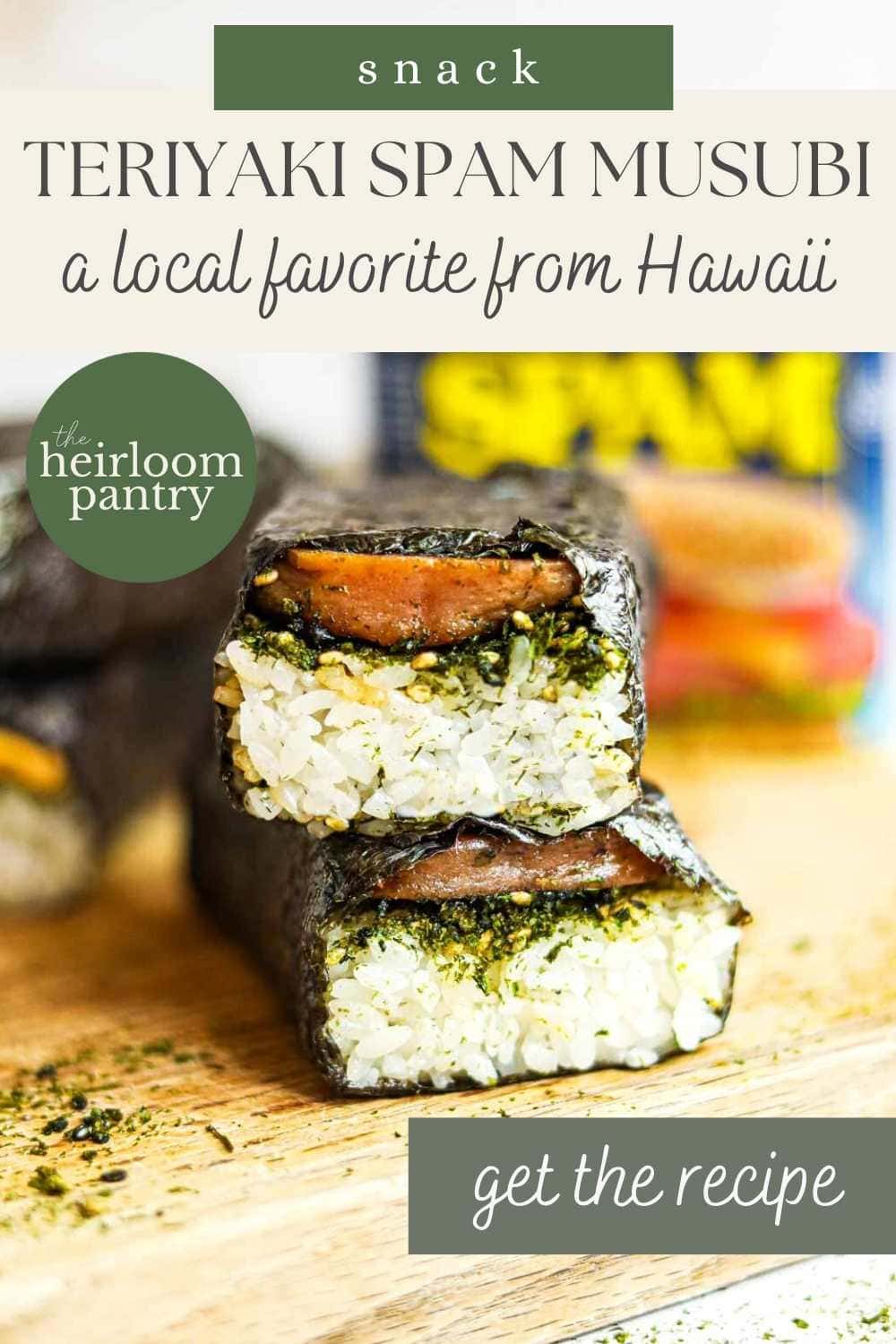
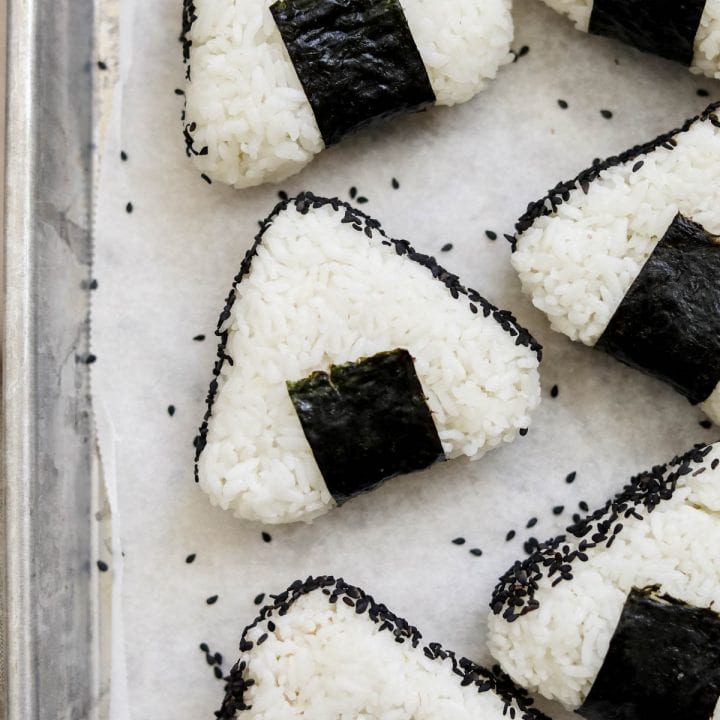
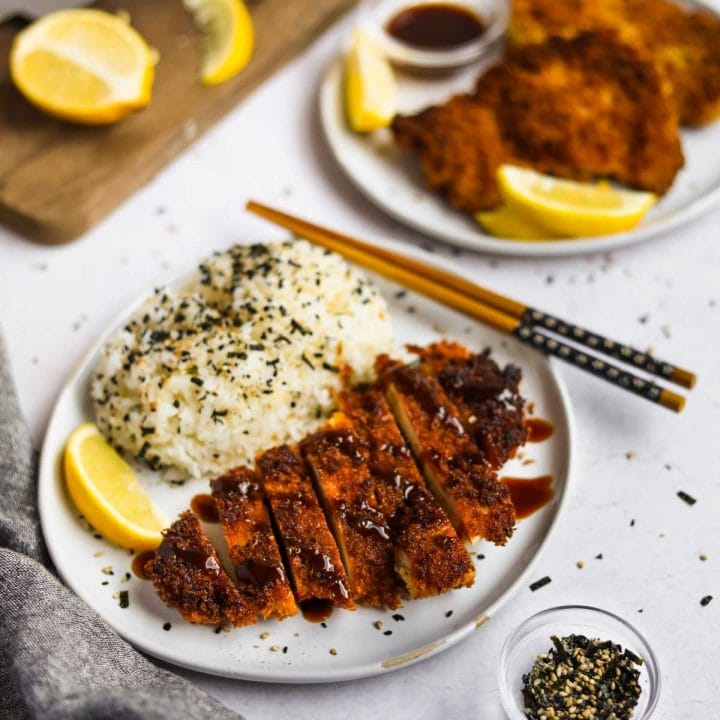
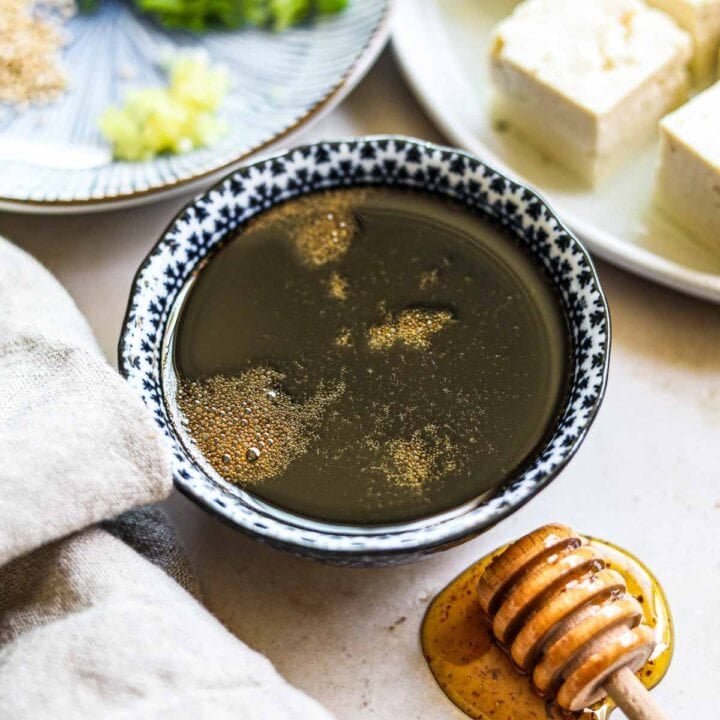
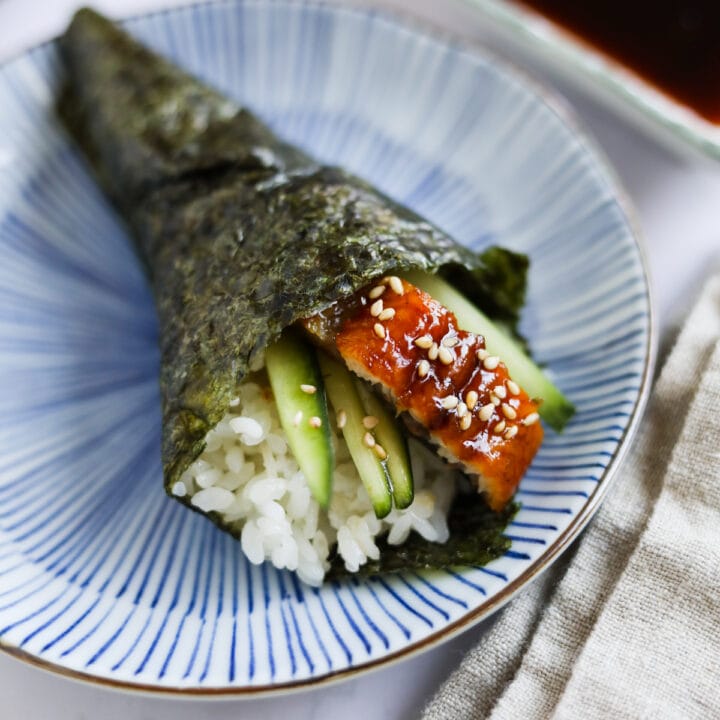
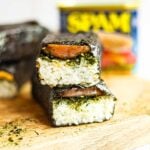
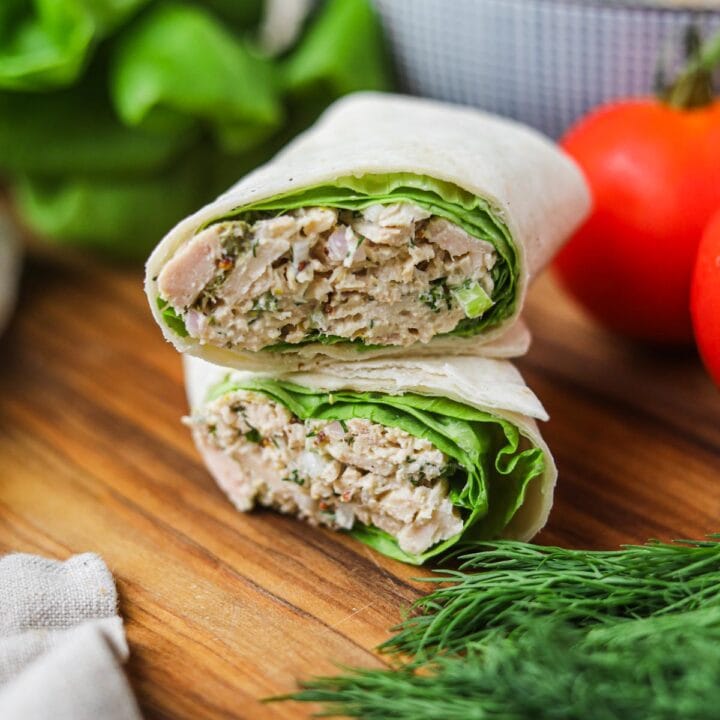
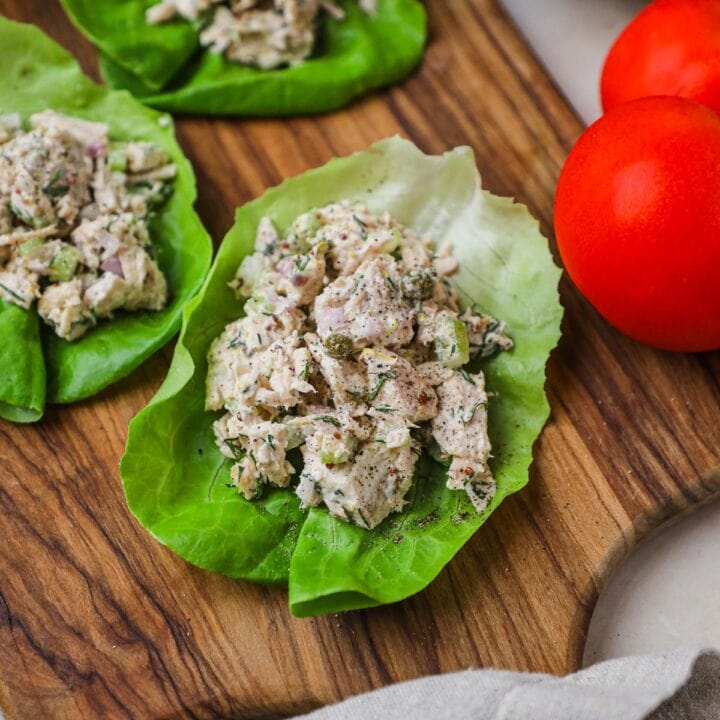
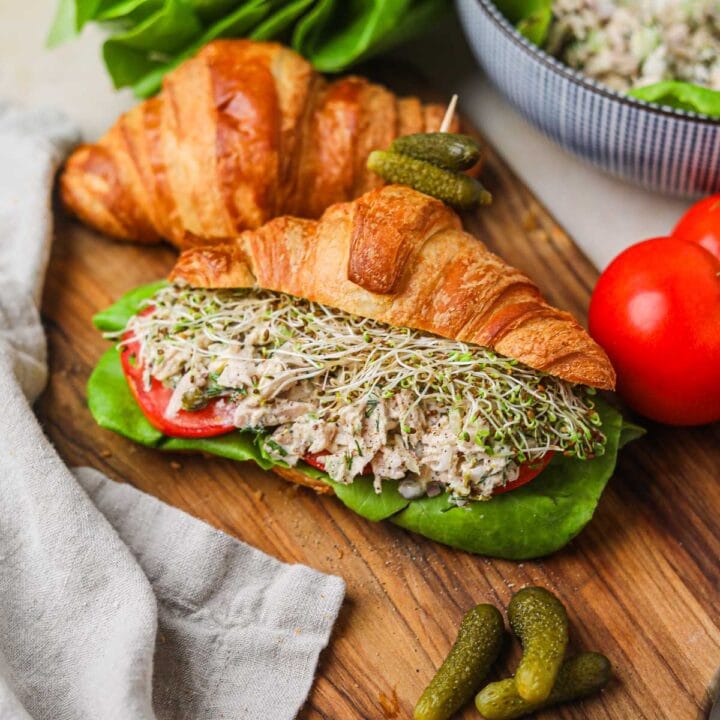
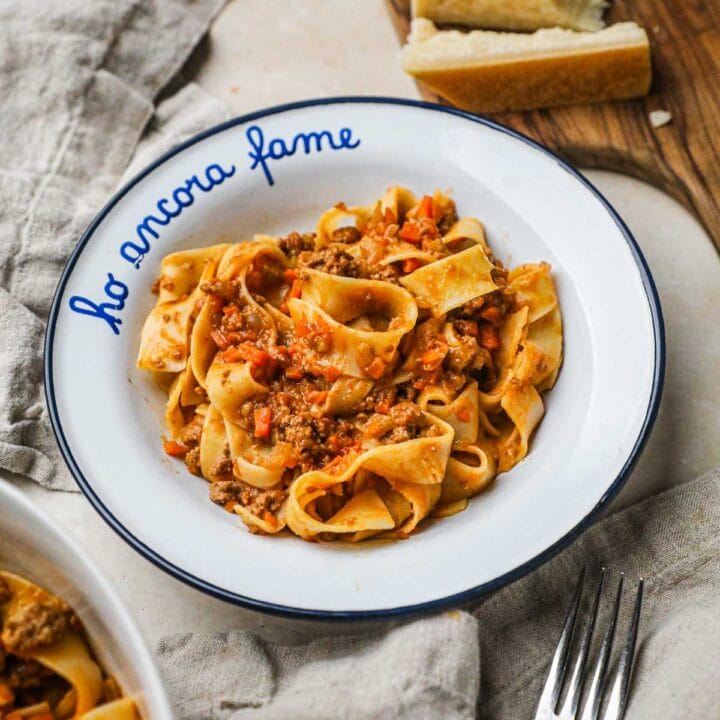
Leave a Reply